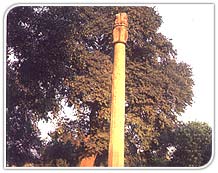Bhopal : Vidisha
 Vidisha
or Besnagar as it is called in the pali sculptures, once the prosperous
capital of the western dominions of the Sungas, contains some remarkable
antiquites that throw light on the considerable architectural
development of the period.
Vidisha
or Besnagar as it is called in the pali sculptures, once the prosperous
capital of the western dominions of the Sungas, contains some remarkable
antiquites that throw light on the considerable architectural
development of the period.
Situated in the fork of the Betwa
and Bes rivers, Vidisha, 10 km from Sanchi, occupies an important place
amonst the ancient cities in India. In the 6th and 5th centuries BC, it
rose to become an important trade contre and a bustling city under the
Sungas, Nagas, Satvahanas and Guptas. The Emperor Ashoka was governor of
Vidisha and it finds mention in Kalidasa's immortal Meghdoor. Deserted
after the 6th century AD it came into prominence again as Bhilsa during
the medieval period (9th to 12 th centuries AD) . It later passed on to
the Malwa Sultans, the Mughals, and the Scindias.
The
ruins of a Brahmanical shrine at Vidisha dedicated to Vishnu reveal that
the foundation bricks were cemented together with lime mortar, the first
known example of the use of cement in India. The ruins are what remains
of possible the oldest known Brahmanical stone structure, dated not
later than 2 BC.
Vidsha museum has a superb collection of
Besnagar's earliest antiquities, dating from the Sunga period; 9th
century sculptures, and terracotta objects, representing the art that
flourished under parmara patronage, are also well represented here.
Highlights of the collection from Besnagar are the Surya and Chamudi
figures, the Yakshi and the Ramagupta inscriptions.
The
Lohangi Rock, gumbaz-ka-Maqbara and Bijamandal Mosque, standing on
the foundations of a temple, are also worth a visit.
Close to
the ruins are the remains of votive pillars with palm-leaf capitals; the
only one the still stands in the Heliodorus pillar, also known
as khambha Baba. A monolithic, free-standing column, the Pillar bears an
inscription which states that it was a Garuda Pillar, raised in honour
of Vasudeva by Heliodorus, a resident of Taxila, who had been sent to
the court of Bhagabhadra as an evnoy of the Indo-Bactrian monarch,
Antialkidas. This inscription is a particularly valuable historical
record, revealing both the relations that existed between the region and
the Greek kingdoms of thd Punjab, and the remarkable fact that a Greek
had become a follower of the Hindu god Vishnu. The inclusion of the name
of Antialkidas dates the approximate erection of the pillar to 140 BC.
Architecturally, the Pillar, with its bell capital carrying a
figured super-structure, resembles the Ashoka Pillar, but is much
smaller in size with more slender proportions. The lower portion of the
shaft is octagonal, the upper, sixteen-sided, with a panel above of
thirty-two facets. The carvings have Buddhist motifs such as a border
with geese in pairs as well as Hellenic ones such as the honeysuckle and
the bead moulding  Vidisha
or Besnagar as it is called in the pali sculptures, once the prosperous
capital of the western dominions of the Sungas, contains some remarkable
antiquites that throw light on the considerable architectural
development of the period.
Vidisha
or Besnagar as it is called in the pali sculptures, once the prosperous
capital of the western dominions of the Sungas, contains some remarkable
antiquites that throw light on the considerable architectural
development of the period.